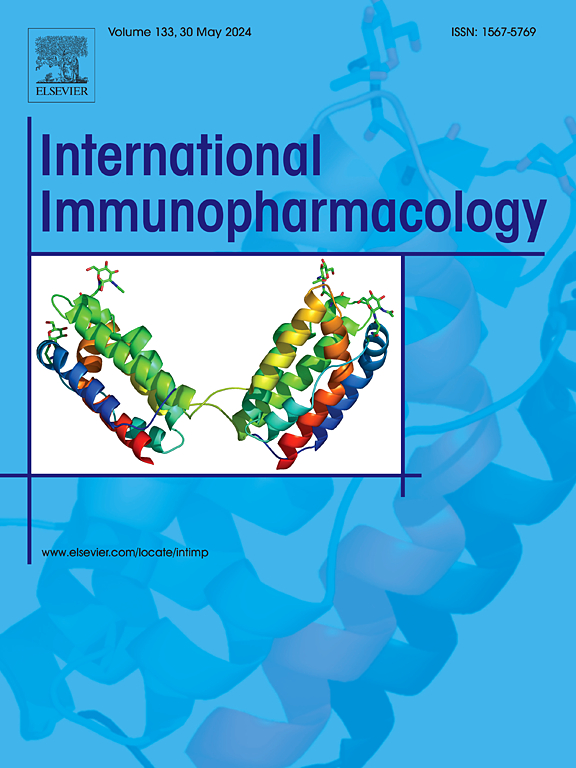角黄素通过抑制Th2免疫反应改善小鼠特应性皮炎。
IF 4.8
2区 医学
Q2 IMMUNOLOGY
引用次数: 0
摘要
特应性皮炎(AD)是一种常见的慢性炎症性皮肤病,其特征是强烈的瘙痒和复杂的免疫致病机制。最近的证据强调了AD进展中肠道微生态失调与免疫反应改变之间的关键联系。代谢物作为肠道微环境的重要组成部分,在各种生理过程中起着举足轻重的作用。通过对AD小鼠模型的代谢组学分析,我们发现与健康对照组相比,AD小鼠中的角黄素(CTX)显著减少,这是一种天然存在于许多食物中的细菌衍生代谢物。为了研究CTX的治疗潜力,我们通过在小鼠耳部和背侧皮肤上反复施用2,4-二硝基氯苯(DNCB)建立AD模型,成功诱导AD样症状和病变。值得注意的是,在dncb诱导的AD模型中,口服CTX可显著减轻皮肤炎症并降低血清IgE水平。体内和体外研究均表明,CTX治疗可有效抑制Th2免疫反应。在机制上,我们发现CTX显著抑制了th2极化T细胞中JAK2-STAT6信号通路的激活。我们的研究结果不仅证明了CTX对AD的治疗效果,而且阐明了其调节T辅助细胞亚群平衡的分子机制。这些发现表明CTX可以作为一种有希望的治疗AD和其他Th2反应介导的免疫疾病的药物。本文章由计算机程序翻译,如有差异,请以英文原文为准。
Canthaxanthin ameliorates atopic dermatitis in mice by suppressing Th2 immune response
Atopic dermatitis (AD) is a prevalent chronic inflammatory skin disorder characterized by intense pruritus and complex immunopathogenic mechanisms. Recent evidence has highlighted the critical link between dysregulated intestinal microecology and altered immune responses in AD progression. As essential components of the intestinal microenvironment, metabolites play pivotal roles in various physiological processes. Through metabolomic profiling in an AD mouse model, we identified a significant reduction in canthaxanthin (CTX), a bacterial-derived metabolite naturally present in many foods, in AD mice compared to healthy controls. To investigate the therapeutic potential of CTX, we established an AD model by repeatedly applying 2,4-dinitrochlorobenzene (DNCB) to the ears and dorsal skin of mice, successfully inducing AD-like symptoms and lesions. Notably, oral administration of CTX significantly attenuated skin inflammation and reduced serum IgE levels in this DNCB-induced AD model. Both in vivo and in vitro studies demonstrated that CTX treatment effectively suppressed Th2 immune responses. Mechanistically, we found that CTX significantly inhibited the activation of the JAK2-STAT6 signaling pathway in Th2-polarized T cells. Our findings not only demonstrate the therapeutic efficacy of CTX in AD but also elucidate its molecular mechanism in modulating T helper cell subset balance. These insights suggest that CTX could serve as a promising therapeutic agent for AD and potentially other Th2 response-mediated immune disorders.
求助全文
通过发布文献求助,成功后即可免费获取论文全文。
去求助
来源期刊
CiteScore
8.40
自引率
3.60%
发文量
935
审稿时长
53 days
期刊介绍:
International Immunopharmacology is the primary vehicle for the publication of original research papers pertinent to the overlapping areas of immunology, pharmacology, cytokine biology, immunotherapy, immunopathology and immunotoxicology. Review articles that encompass these subjects are also welcome.
The subject material appropriate for submission includes:
• Clinical studies employing immunotherapy of any type including the use of: bacterial and chemical agents; thymic hormones, interferon, lymphokines, etc., in transplantation and diseases such as cancer, immunodeficiency, chronic infection and allergic, inflammatory or autoimmune disorders.
• Studies on the mechanisms of action of these agents for specific parameters of immune competence as well as the overall clinical state.
• Pre-clinical animal studies and in vitro studies on mechanisms of action with immunopotentiators, immunomodulators, immunoadjuvants and other pharmacological agents active on cells participating in immune or allergic responses.
• Pharmacological compounds, microbial products and toxicological agents that affect the lymphoid system, and their mechanisms of action.
• Agents that activate genes or modify transcription and translation within the immune response.
• Substances activated, generated, or released through immunologic or related pathways that are pharmacologically active.
• Production, function and regulation of cytokines and their receptors.
• Classical pharmacological studies on the effects of chemokines and bioactive factors released during immunological reactions.

 求助内容:
求助内容: 应助结果提醒方式:
应助结果提醒方式:


